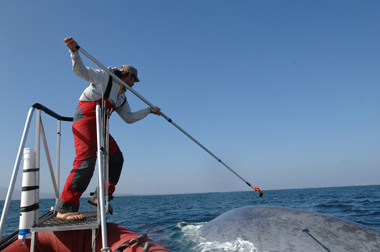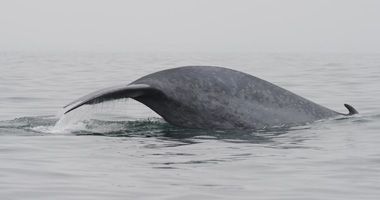Campus News
Military sonar can alter blue whale behavior
Blue whales off the coast of California changed their behavior when exposed to underwater sounds like those used in U.S. military exercises.


Some blue whales off the coast of California change their behavior when exposed to underwater sounds like those used in U.S. military exercises. These behavioral changes may cause them to alter diving behavior or temporarily avoid important feeding areas, according to experiments conducted by an international team of marine scientists.
The Southern California Behavioral Response Study (SoCal-BRS) exposed tagged blue whales in the California Bight to simulated mid-frequency (3.5-4 kHz) sonar sounds at several orders of magnitude lower power than the military uses.
Animal-borne tags attached with non-invasive suction cups recorded acoustic data and high-resolution animal movements as the animals were exposed to the controlled sounds. The tags enabled researchers to see that some of the whales that had been engaged in deep feeding stopped eating and either sped up or moved away from the source of the noise.
“The tag technology we use offers a unique glimpse into the underwater behavior of whales that otherwise would not be possible,” said Ari Friedlaender, a research scientist at the Duke Marine Laboratory and an adjunct researcher at the University of California, Santa Cruz (UCSC).
The study, which was funded by the U.S. Navy Chief of Naval Operations Environmental Readiness Division and the U.S. Office of Naval Research, appears July 3 in the Proceedings of the Royal Society – B.
Not all the whales responded to the noise, and not all responded in the same way.
“Whales clearly respond in some conditions by modifying diving behavior and temporarily avoiding areas where sounds were produced,” said lead author Jeremy Goldbogen of Cascadia Research. “But overall the responses are complex and depend on a number of interacting factors,” including whether or not they were feeding and, if they were feeding, how deep they were.
John Calambokidis of Cascadia Research, one of the project’s lead investigators, noted that blue whales are the largest animal that has ever lived and their populations globally remain at a fraction of their former numbers prior to whaling. “They appear regularly off the southern California coast, where they feed. But that area of the ocean is also the site of military training and testing exercises that involve loud mid-frequency sonar signals,” he said. “Such sonar exercises have been associated with several unusual strandings of other marine mammal species (typically beaked whales) in the past. Until this study, almost no information was available about whether and how blue whales respond to sonar.”
The SoCal-BRS chief scientist is Brandon Southall, president of SEA, Inc., and an adjunct researcher at both UC Santa Cruz and Duke University. “These are the first direct measurements of individual responses for any baleen whale species to these kinds of mid-frequency sonar signals,” he said. “These findings help us better understand risks to these animals from human sound and inform timely conservation and management decisions.”
A related paper published by this research team in the journal Biology Letters has shown clear and even stronger responses of Cuvier’s beaked whales to simulated mid-frequency sonar exposures at much lower sound exposure levels than expected. Beaked whales showed a variety of responses to both actual military sonar in the distance and nearby simulated sonar. What the beaked whales were doing at the time appeared to be a key factor affecting their reactions.